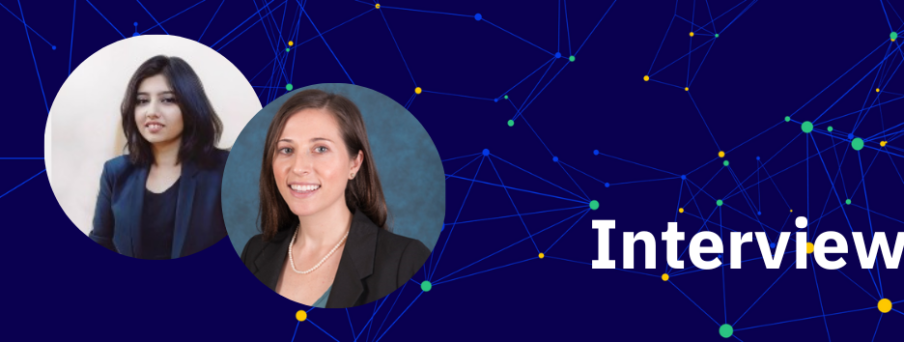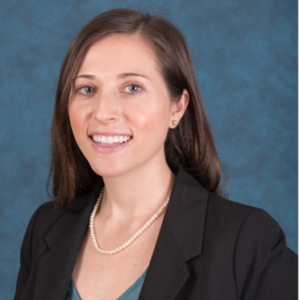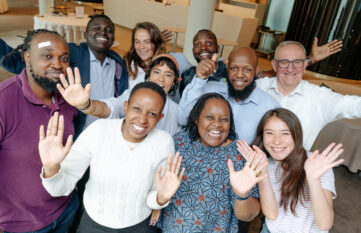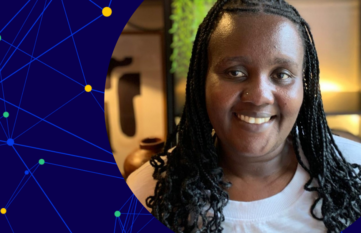How can digital financial services help women achieve greater economic participation, Tasnuba Sinha and Kym Cole?

Promoting women’s economic empowerment is key when it comes to closing the gender gap. We’ve set down with Tasnuba Sinha and Kym Cole of WEE-DiFine to get insights on latest research results and how to ensure a fair digital financial future for all.
WEE-DiFine is a research initiative that seeks to generate a comprehensive body of evidence that addresses the impact of digital financial services (DFS) on women’s economic empowerment (WEE) and the causal mechanisms between the two by funding rigorous research across South Asia, Sub-Saharan Africa, and Southeast Asia.
Why are digital financial services (DFS) important for women’s economic empowerment (WEE) and what kind of digital financial services does WEE particularly promote, especially on the last mile?
Tasnuba: Digital financial services are important for women’s economic empowerment because they can provide women with greater access to financial tools like savings, credit, and insurance. Mobile money and mobile financial services in particular can reach women in remote areas and give them more control over their finances. This enables women to start or expand businesses, save, manage household expenses, cover emergencies, and increase financial resilience.
Kym: We see that digital financial services have a unique ability to address constraints that can be especially salient for women. WEE-DiFine’s white paper actually presents a causal framework of the mechanisms through which digital financial services (DFS) impacts WEE. As an example, women who lack DFS and transact in cash may face physical security threats and an inability to maintain the privacy of their financial information, especially from spouses and other family members. The types of DFS that effectively promote WEE, especially on the last mile, really depend on the context and women in question, but mobile financial services can be particularly game-changing for rural women and women that face mobility constraints.
Can you provide examples of successful cases where greater access to DFS has had a positive impact on women’s economic empowerment? What lessons can be drawn from these examples?
Tasnuba: There are several notable examples illustrating the impact of DFS on women’s economic empowerment. For instance, M-Pesa (a money transfer system) in Kenya stands out as a transformative tool for women entrepreneurs, facilitating transactions and fostering financial independence. In Bangladesh, microcredit programs provided accessible loans to rural women, boosting entrepreneurship and financial stability. Additionally, eNAM (an online trading platform for agricultural commodities in India) in India empowered women farmers through direct sales, elevating incomes and market engagement.
These successes underscore critical lessons. Firstly, tailored services meeting women’s financial needs are pivotal. Secondly, investing in digital literacy significantly enhances adoption rates. Thirdly, addressing cultural barriers to technology is crucial for widespread usage. Lastly, collaborative efforts among various stakeholders drive meaningful and sustainable impacts on women’s economic empowerment through DFS.
Kym: Absolutely, our funded studies have in fact quantified impacts of DFS on WEE. In a pilot randomized controlled trial in partnership with BRAC Tanzania (a nonprofit organisation dedicated to supporting communities affected by poverty), researchers found that encouraging women to repay loans through mobile money, rather than in cash, resulted in statistically significant improvements on an index of financial control and on an index of decision making within the household. This study also found larger impacts amongst women who were the least empowered at baseline. The implications are powerful: DFS has the potential to make a substantive difference for the most vulnerable women.
When developing digital financial services, how can it be ensured that the design is inclusive and caters to the diverse needs of women, particularly of those in marginalized communities? Do you see that this is addressed by financial institutions? What is WEE-DiFine’s approach to this?
Tasnuba: Inclusive DFS design involves consulting women users during development, designing intuitive interfaces, offering products tailored to women’s financial lives like small-sized loans and savings accounts, and using female agents to build trust. More financial institutions need to adopt this approach.
Kym: Since WEE-DiFine’s mandate is to support rigorous research and disseminate the results, we don’t have a formal position on inclusive product design. However, approaches that co-create contextualized solutions in partnership with women are in line with WEE-DiFine’s values and ethos.
One trend that we tend to see amongst financial institutions, and one that we need to be wary of, is conflating female-focused branding with female-centered design. It’s important to avoid simply pink-washing products and claiming that they are intentionally designed for women. Female-centered design truly takes into account a woman’s unique experience with a product. In Bangladesh, for example, women are often required to remove any head coverings to take registration photos for their DFS accounts. For many Muslim women, this is a deeply uncomfortable and culturally inappropriate experience. Additionally, it’s important to avoid generalizing “women” as a homogenous population.
One area where I think we still need to see major progress in this regard is designing digital financial products specifically for women with disabilities, who may face unique hurdles using these products. This BIGD (BRAC Institute of Governance and Development) study, in my opinion, is a great example of how researchers can thoughtfully and systematically identify the barriers that different groups of women face in their DFS onboarding journeys.
What role does the private sector play: Do you foresee an enabling fintech ecosystem characterized by a broad set of non-traditional financial service providers, regulatory sandboxes, and the like?
Tasnuba: The private sector should develop business models serving low-income segments, collaborate with NGOs, support digital literacy programs, and participate in regulatory sandboxes to test new offerings. An enabling fintech ecosystem expands options for women.
Kym: Absolutely, I foresee an enabling fintech ecosystem as one involving a variety of players. The private sector has a nimbleness that can be helpful for rapid product design, testing, and iteration. But the design of products catering to the needs of vulnerable and marginalized women should include inputs from cross sectoral actors that truly understand these populations and hold their best interests at heart.
What role does the development cooperation sector play: How can its actors support capacity-building efforts to empower women to effectively make use of digital financial services?
Tasnuba: Development organizations can provide digital skills training for women, fund pilot programs, develop localization content, and support evidence gathering to shape policy. Capacity building for women is key.
Kym: Quantitative evidence (including that generated under WEE-DiFine) increasingly demonstrates that providing women with access to DFS simply isn’t enough – capacity building is critical to advancing women’s financial inclusion. Tangentially, rigorous research is essential to identifying what works, for whom, in what context, and what interventions may in fact have unintended negative impacts on women. Development organizations play a critical role in this process of knowledge generation.
What role does the political sector play: Are there specific policy recommendations or regulatory frameworks that you believe would facilitate digital financial inclusion for women?
Tasnuba: The political sector plays a critical role in shaping an environment conducive to women’s digital financial inclusion. Policies ensuring gender-neutral access to technology, promoting financial literacy in educational curricula, and incentivizing financial institutions to cater to women’s needs are essential. Regulatory frameworks should mandate data privacy and protection while encouraging innovative DFS tailored for women, fostering an inclusive financial landscape.
Women and female entrepreneurs are lagging behind men and male entrepreneurs in both digital access and generation of data trails. What can be done to overcome this challenge? How can the risk of unintentionally reinforcing limiting social norms because of DFS be limited?
Tasnuba: To overcome this gap, targeted interventions are crucial. Tailored digital literacy programs must address barriers faced by women, emphasizing their unique financial roles. Engaging local influencers and role models can counter reinforcing social norms. Regulators should enforce inclusive data collection practices, ensuring DFS don’t perpetuate biases but instead challenge societal constraints by empowering women economically.
Kym: So many factors contribute to these gender gaps, but one that I think often gets overlooked is the role of self-confidence and perceived self-value. Various subtle influences, including cultural norms, can nudge women to believe that DFS “is not for them,” a trend quantified by one WEE-DiFine supported study. Potential solutions include helping build women’s comfort and confidence with these products and creating spaces where women can come together to support each other; women’s self help groups may be a promising vehicle to do so, as demonstrated by this WEE-DiFine supported study in India.
“So many factors contribute to these gender gaps, but one that I think often gets overlooked is the role of self-confidence and perceived self-value. Various subtle influences, including cultural norms, can nudge women to believe that digital financial services “are not for them,” […]. Potential solutions include helping build women’s comfort and confidence with these products and creating spaces where women can come together to support each other.”
Kym Cole
How can we increase the digital trails of women in a way that opens opportunities for financial services providers to foster data-driven product innovation for women and women entrepreneurs?
Tasnuba: Boosting women’s digital trails requires a two-pronged approach: incentivize participation through rewards and accessible platforms, and build trust through data privacy and control. This generates rich data that fuels innovations like personalized financial products and microloans, tailored to meet the unique needs of women and female entrepreneurs. It’s a virtuous cycle where data empowers women, not exploits them, paving the way for a more inclusive and financially secure future.
How can we leverage digital public infrastructure (e.g., digital ID system) and digital technology to bolster women’s and female entrepreneurs’ resilience?
Tasnuba: Imagine a world where women and female entrepreneurs navigate challenges with newfound agility, thanks to a digital safety net woven from public infrastructure and tech. Digital IDs can be the foundation, providing secure access to services and financial tools like microloans and insurance, mitigating income shocks. Online platforms offer real-time market information and training resources, building knowledge and adaptability. Think remote healthcare consultations for quick responses to health emergencies, and disaster early warning systems fostering proactive preparedness. By connecting them to networks and communities, digital platforms also strengthen social support and collective resilience. This digital ecosystem doesn’t just equip women with tools; it fosters confidence, autonomy, and the ability to bounce back stronger from any adversity.
Kym: Digital technological innovations hold immense potential to bolster women’s resilience, but we often see low demand for new products, particularly if they are market-based. The challenge lies in illustrating that these products are in fact a good use of women’s time and money, and that they can be user-friendly. One WEE-DiFine supported study offers a promising way forward in this regard – researchers re-framed digital livestock insurance in a manner that spoke directly to pastoral women’s needs and offered subsidies on the product. When presented with this combination, women’s demand for the insurance product surged. The implications are powerful – understanding women’s unique needs, designing products that directly cater to these needs, and allowing women space to safely experiment with an unfamiliar innovation may be key to securing their adoption of resilience-boosting technology.
“By connecting them to networks and communities, digital platforms also strengthen social support and collective resilience. This digital ecosystem doesn’t just equip women with tools; it fosters confidence, autonomy, and the ability to bounce back stronger from any adversity.”
Tasnuba Sinha
If you look ten years into the future: What would the world around DFS need to look like for you to say: “Yes, we’ve reached our goal!”?
Tasnuba: In a decade, successful DFS implementation would mean ubiquitous access to tailored financial services for women globally. It would manifest in gender-equal digital access, empowered by comprehensive digital literacy. Financial systems would thrive on inclusive data trails, fueling innovative, personalized products benefiting women and entrepreneurs. Regulatory frameworks would safeguard privacy and ensure fair access. The success marker: women leveraging DFS to achieve economic autonomy, narrowing gender gaps, and fostering a more equitable financial landscape worldwide.
Kym: I agree with the vision Tasnuba shared. I would add that I would love to see tailored financial services particularly for women that have been systematically excluded from DFS access, including women with low levels of literacy and numeracy and women with disabilities.

Tasnuba Sinha is the Initiative Communications Manager, WEE-DiFine and WEE-Connect. Prior to joining BIGD, Tasnuba was a Digital Tools Manager at DAI, where she managed digital tools to build the capacity of value chain actors and empower vulnerable groups. She has also worked with FHI 360, where she promoted financial awareness and women’s financial inclusion in the garment industry.
At Startup Dhaka, she drove business growth and supported entrepreneurs through strategic planning and accelerator programs. Tasnuba holds an Executive MBA from North South University and a Bachelor of Social Science in Economics from BRAC University.

Kym Cole is the Initiative Director of WEE-DiFine and WEE-Connect. She holds a BA in Anthropology from the University of Pennsylvania and a Master of Public Policy from the Harvard Kennedy School. She has worked as a consultant at the World Bank and as a Research Manager with Innovations for Poverty Action (IPA) Ghana, where she managed the country office’s private sector portfolio.
Kym was a Senior Program Manager in the Impact Evaluation division at Social Impact, where she managed large-scale quantitative evaluations. Kym is passionate about the intersection of rigorous research and women’s economic empowerment, financial inclusion, and SME development.


